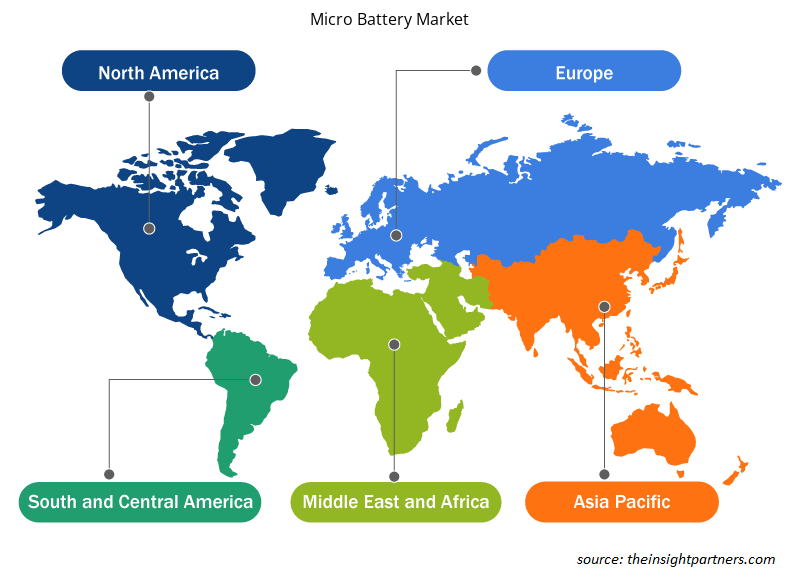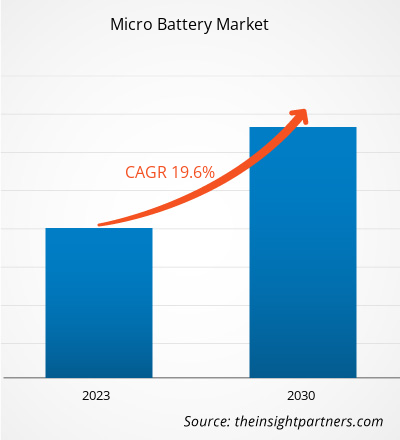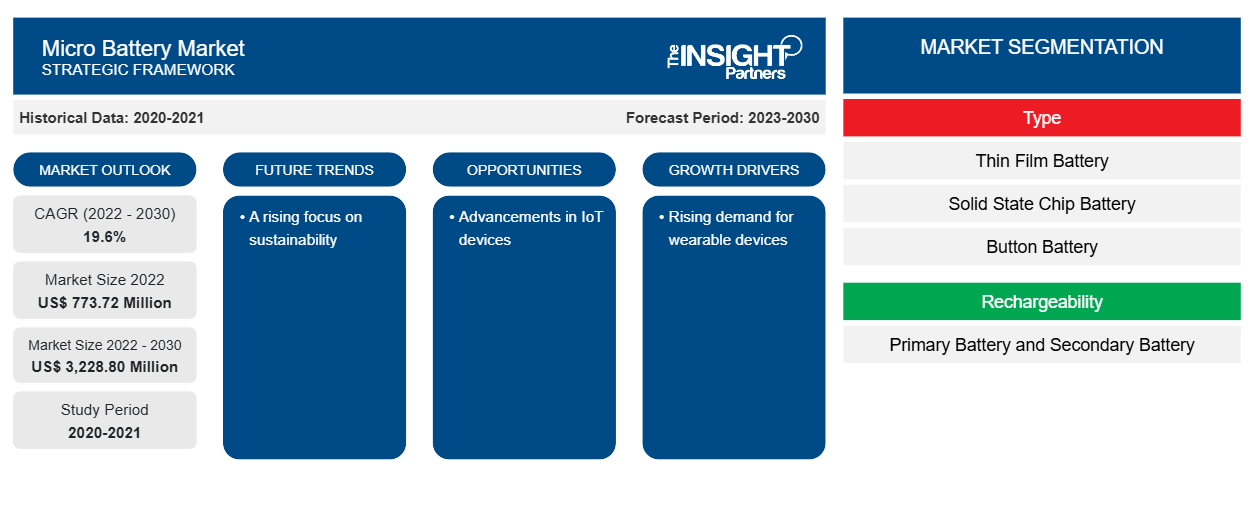من المتوقع أن يصل حجم سوق البطاريات الصغيرة إلى 3228.80 مليون دولار أمريكي بحلول عام 2030 من 773.72 مليون دولار أمريكي في عام 2022. ومن المتوقع أن يسجل السوق معدل نمو سنوي مركب بنسبة 19.6٪ خلال الفترة 2022-2030. ومن المرجح أن يظل الطلب المتزايد على الأجهزة القابلة للارتداء وتصغير حجم الإلكترونيات الاستهلاكية اتجاهًا رئيسيًا في السوق.
تحليل سوق البطاريات الصغيرة
لقد شهد سوق البطاريات الصغيرة نموًا ملحوظًا في السنوات الأخيرة. تساهم عوامل مثل التحول نحو الأجهزة القابلة للارتداء في نمو سوق البطاريات الصغيرة. كما تعزز سوق البطاريات الصغيرة العالمية من خلال الوعي المتزايد بمزاياها، مثل نطاق درجة حرارة التشغيل الواسع وكثافة الطاقة العالية. سيخلق التوسع في صناعة الرعاية الصحية والتقدم في أجهزة إنترنت الأشياء فرصًا مربحة في سوق البطاريات الصغيرة.
نظرة عامة على سوق البطاريات الصغيرة
في عالم الأنظمة والأدوات الإلكترونية الصغيرة، تلعب البطاريات الصغيرة دورًا حاسمًا لأنها مصممة خصيصًا لتوفير الطاقة في المواقف التي تكون فيها المساحة محدودة. قد لا تكون البطاريات الأكبر التقليدية مناسبة لأجهزة مثل أجهزة السمع وأجهزة الاستشعار والغرسات الطبية وغيرها من الأجهزة الإلكترونية الدقيقة بسبب قيود حجمها. وهنا يأتي دور البطاريات الصغيرة، حيث تعمل كخيار مفضل في مثل هذه السيناريوهات. إن التبني المتزايد للتكنولوجيا القابلة للارتداء، إلى جانب توسع قطاع أشباه الموصلات وارتفاع الاستثمارات الخاصة في البحث والتطوير التقني لتكنولوجيا إنترنت الأشياء (IoT)، يدفع السوق.
قم بتخصيص هذا التقرير ليناسب متطلباتك
ستحصل على تخصيص لأي تقرير - مجانًا - بما في ذلك أجزاء من هذا التقرير، أو تحليل على مستوى الدولة، وحزمة بيانات Excel، بالإضافة إلى الاستفادة من العروض والخصومات الرائعة للشركات الناشئة والجامعات
- احصل على أهم اتجاهات السوق الرئيسية لهذا التقرير.ستتضمن هذه العينة المجانية تحليلاً للبيانات، بدءًا من اتجاهات السوق وحتى التقديرات والتوقعات.
محركات وفرص سوق البطاريات الصغيرة
تصغير حجم الأجهزة الإلكترونية الاستهلاكية
إن التصغير المتزايد للإلكترونيات الاستهلاكية هو عامل مهم يدفع نمو سوق البطاريات الصغيرة. في عالم اليوم سريع الخطى، أصبحت الإلكترونيات الاستهلاكية جزءًا لا يتجزأ من حياة الجميع. من الهواتف الذكية إلى الأجهزة القابلة للارتداء، يستمر الطلب على الأدوات الأصغر والأكثر قوة في الارتفاع. مع استمرار انكماش حجم الإلكترونيات الاستهلاكية، تكافح تقنيات البطاريات التقليدية لمواكبة الطلب على مصادر الطاقة المدمجة وطويلة الأمد. ظهرت البطاريات الصغيرة، المعروفة أيضًا باسم مصادر الطاقة الصغيرة، كحل لهذه المشكلة. توفر أجهزة تخزين الطاقة الصغيرة هذه كثافة طاقة عالية في عامل شكل صغير، مما يجعلها مثالية لتشغيل الإلكترونيات الاستهلاكية المتقلصة باستمرار.
تزايد انتشار الأجهزة القابلة للارتداء
إن التركيز المتزايد على اللياقة البدنية هو المحرك وراء تبني الأجهزة القابلة للارتداء لأنها تساعد المستخدم على مراقبة مستوى الأكسجين وعدد الخطوات ومعدل ضربات القلب والعديد من المعلمات الأخرى. بالإضافة إلى ذلك، فهي تساعد أيضًا في عرض الرسائل النصية وتتبع الموقع باستخدام نظام تحديد المواقع العالمي (GPS) والعديد من الميزات الأخرى. تتطلب هذه التقنية القابلة للارتداء حل بطارية للعمل بكفاءة، مما يدفع الطلب على البطاريات الصغيرة.
تقرير تحليل تجزئة سوق البطاريات الصغيرة
إن القطاعات الرئيسية التي ساهمت في اشتقاق تحليل سوق البطاريات الصغيرة هي النوع، وإمكانية إعادة الشحن، والتطبيق.
- وفقًا للنوع، يتم تقسيم سوق البطاريات الصغيرة إلى بطاريات الأغشية الرقيقة وبطاريات الرقائق ذات الحالة الصلبة وبطاريات الأزرار. احتلت شريحة بطاريات الأغشية الرقيقة أكبر حصة في السوق في عام 2022.
- من حيث قابلية إعادة الشحن، يتم تقسيم السوق إلى بطارية أساسية وبطارية ثانوية. احتلت شريحة البطارية الأساسية الحصة الأكبر من السوق في عام 2022.
- من حيث التطبيق، يتم تقسيم السوق إلى الإلكترونيات الاستهلاكية، والتعبئة الذكية، والأجهزة الطبية، وعقد الاستشعار اللاسلكية، وغيرها. احتل قطاع الإلكترونيات الاستهلاكية الحصة الأكبر من السوق في عام 2022.
تحليل حصة سوق البطاريات الصغيرة حسب المنطقة الجغرافية
ينقسم النطاق الجغرافي لتقرير سوق البطاريات الصغيرة بشكل أساسي إلى خمس مناطق: أمريكا الشمالية، وآسيا والمحيط الهادئ، وأوروبا، والشرق الأوسط وأفريقيا، وأمريكا الجنوبية والوسطى.
تحتل أمريكا الشمالية حصة سوقية عالمية كبيرة في عام 2022. يعد الوعي باللياقة البدنية أحد العوامل الرئيسية التي تدفع الطلب على الأجهزة القابلة للارتداء، مما يكمل نمو السوق. يؤدي الطلب على الأجهزة الإلكترونية الصغيرة والمدمجة إلى الحاجة إلى بطاريات صغيرة. يخلق الاستثمار في حلول البطاريات فرصة كبيرة للبحث والتطوير في مجال البطاريات الصغيرة. على سبيل المثال، في نوفمبر 2023، أعلنت وزارة الطاقة الأمريكية (DOE) عن ما يصل إلى 3.5 مليار دولار أمريكي من قانون البنية التحتية لتعزيز الإنتاج المحلي للبطاريات المتقدمة ومواد البطاريات على مستوى البلاد.
رؤى إقليمية حول سوق البطاريات الصغيرة
لقد قام المحللون في Insight Partners بشرح الاتجاهات والعوامل الإقليمية المؤثرة على سوق البطاريات الصغيرة طوال فترة التوقعات بشكل شامل. يناقش هذا القسم أيضًا قطاعات سوق البطاريات الصغيرة والجغرافيا في جميع أنحاء أمريكا الشمالية وأوروبا ومنطقة آسيا والمحيط الهادئ والشرق الأوسط وأفريقيا وأمريكا الجنوبية والوسطى.

- احصل على البيانات الإقليمية المحددة لسوق البطاريات الصغيرة
نطاق تقرير سوق البطاريات الصغيرة
| سمة التقرير | تفاصيل |
|---|---|
| حجم السوق في عام 2022 | 773.72 مليون دولار أمريكي |
| حجم السوق بحلول عام 2030 | 3,228.80 مليون دولار أمريكي |
| معدل النمو السنوي المركب العالمي (2022 - 2030) | 19.6% |
| البيانات التاريخية | 2020-2021 |
| فترة التنبؤ | 2023-2030 |
| القطاعات المغطاة | حسب النوع
|
| المناطق والدول المغطاة | أمريكا الشمالية
|
| قادة السوق وملفات تعريف الشركات الرئيسية |
|
كثافة اللاعبين في سوق البطاريات الصغيرة: فهم تأثيرها على ديناميكيات الأعمال
يشهد سوق البطاريات الصغيرة نموًا سريعًا، مدفوعًا بالطلب المتزايد من المستخدم النهائي بسبب عوامل مثل تفضيلات المستهلكين المتطورة والتقدم التكنولوجي والوعي المتزايد بفوائد المنتج. ومع ارتفاع الطلب، تعمل الشركات على توسيع عروضها والابتكار لتلبية احتياجات المستهلكين والاستفادة من الاتجاهات الناشئة، مما يؤدي إلى زيادة نمو السوق.
تشير كثافة اللاعبين في السوق إلى توزيع الشركات أو المؤسسات العاملة في سوق أو صناعة معينة. وهي تشير إلى عدد المنافسين (اللاعبين في السوق) الموجودين في مساحة سوق معينة نسبة إلى حجمها أو قيمتها السوقية الإجمالية.
الشركات الرئيسية العاملة في سوق البطاريات الصغيرة هي:
- شركة موليكس المحدودة
- شركة موراتا للتصنيع المحدودة
- شركة فارتا ايه جي
- شركة دوراسيل
- شركة ريناتا
- شركة ماكسيل القابضة المحدودة
إخلاء المسؤولية : الشركات المذكورة أعلاه ليست مرتبة بأي ترتيب معين.

- احصل على نظرة عامة على أهم اللاعبين الرئيسيين في سوق البطاريات الصغيرة
أخبار سوق البطاريات الصغيرة والتطورات الأخيرة
يتم تقييم سوق البطاريات الصغيرة من خلال جمع البيانات النوعية والكمية بعد البحث الأولي والثانوي، والتي تتضمن منشورات الشركات المهمة وبيانات الجمعيات وقواعد البيانات. فيما يلي بعض التطورات في سوق البطاريات الصغيرة:
- أعلنت وزارة الطاقة الأمريكية عن إطلاق جائزة تصميم البطاريات الصغيرة. تمنح هذه المسابقة المكونة من مرحلتين ما يصل إلى 1.1 مليون دولار أمريكي في شكل تمويل فيدرالي وخدمات اختبار الأداء والسلامة مع مختبرات وزارة الطاقة الوطنية لمشاريع تصميم البطاريات الصغيرة المبتكرة التي تؤدي إلى تحسين الأداء والسلامة وقابلية إعادة التدوير. (المصدر: مكتب كفاءة الطاقة والطاقة المتجددة، بيان صحفي، مارس 2023)
تقرير سوق البطاريات الصغيرة يغطي المنتجات المطلوبة
يوفر تقرير "حجم سوق البطاريات الصغيرة والتوقعات (2020-2030)" تحليلاً مفصلاً للسوق يغطي المجالات التالية:
- حجم سوق البطاريات الصغيرة وتوقعاتها على المستويات العالمية والإقليمية والوطنية لجميع قطاعات السوق الرئيسية التي يغطيها النطاق
- اتجاهات سوق البطاريات الصغيرة، بالإضافة إلى ديناميكيات السوق مثل المحركات والقيود والفرص الرئيسية
- تحليل مفصل لقوى PEST/Porter الخمس وSWOT
- تحليل سوق البطاريات الصغيرة يغطي اتجاهات السوق الرئيسية والإطار العالمي والإقليمي واللاعبين الرئيسيين واللوائح والتطورات الأخيرة في السوق
- تحليل المشهد الصناعي والمنافسة الذي يغطي تركيز السوق، وتحليل خريطة الحرارة، واللاعبين البارزين، والتطورات الأخيرة لسوق البطاريات الصغيرة
- ملفات تعريف الشركة التفصيلية
- التحليل التاريخي (سنتان)، سنة الأساس، التوقعات (7 سنوات) مع معدل النمو السنوي المركب
- تحليل PEST و SWOT
- حجم السوق والقيمة / الحجم - عالمي، إقليمي، بلد
- الصناعة والمنافسة
- مجموعة بيانات إكسل
التقارير الحديثة
تقارير ذات صلة
شهادات العملاء
سبب الشراء
- اتخاذ قرارات مدروسة
- فهم ديناميكيات السوق
- تحليل المنافسة
- رؤى العملاء
- توقعات السوق
- تخفيف المخاطر
- التخطيط الاستراتيجي
- مبررات الاستثمار
- تحديد الأسواق الناشئة
- تحسين استراتيجيات التسويق
- تعزيز الكفاءة التشغيلية
- مواكبة التوجهات التنظيمية





















 احصل على عينة مجانية ل - سوق البطاريات الصغيرة
احصل على عينة مجانية ل - سوق البطاريات الصغيرة